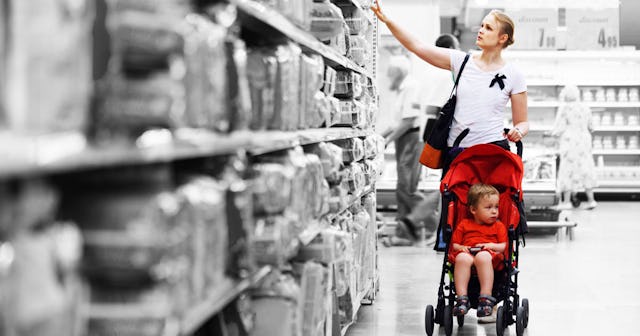Why Diapers Are Getting Harder To Come By

When I had my first son in 2014, I had a baby shower with close to 100 guests. The mere idea of being in a room with that many people now literally makes me want to hyperventilate, but that’s neither here nor there. Despite the amount of times people harass moms about having a baby registry, most guests never even look at that thing. Long story short, I didn’t have to buy diapers for my oldest until he was well past a year old. I had SO MANY diapers. It was a blessing because I didn’t have to worry about that added expense. I also had no idea how much diapers cost for a newborn.
This was, of course, before I had my second child four months ago. Talk about a rude awakening.
Enter the great (horrible) diaper shortage of 2021.
You read that right, my friends. As if we don’t have enough to worry about, families are struggling to cover their baby’s bottoms.
According to the National Diaper Bank Network, 1 in 3 American families struggle with diaper need. There are 5 million infants and toddlers living in poor or low-income families. And of course, government programs such as WIC and food stamps do not provide funds for these.
Couple these statistics with the ongoing pandemic, and it’s likely that even more families are faced with this struggle. More families are turning to help from local diaper banks due to losing their jobs or other financial struggles. In a recently published article in the New York Times, it was discussed how the pandemic has upended global supply chains and created a run on many products, including diapers. Kimberly-Clark and Procter & Gamble, two of the country’s largest diaper manufacturers, increased the prices of baby products this year.
The average cost of diapers in most online retailers is between $30-$50 for a pack of 100 diapers. A newborn can use anywhere between 10-12 diapers a day. This means many families are spending $75 or more for a months supply of diapers for ONE baby. I can think of three moms off the top of my head right now that I know with multiple children in diapers. For some, this could be the difference between covering their baby’s bottom, and getting groceries or paying for other family necessities.
VLG/Getty
The parental guilt from not being able to provide your child with the basic necessities is taking a mental and emotional toll on parents that the public is, per usual, choosing to overlook.
Cost aside, there’s like… an actual diaper SHORTAGE, y’all! So even for families who are not struggling financially and can get to the store, some of these stores don’t have the stock! As a mom to a four-month-old, I have personally experienced having to head to multiple different retail locations to get the correct size of diapers. I even contemplated putting her in diapers that were two sizes too big last week when we ran out on our family vacation. And it was simply because none of the local stores had her size available. So I completely understand that not everybody has that kind of time or resources disposable.
In February, Senator Tammy Duckworth introduced The End Diaper Need Act of 2021. The proposed grant program would provide for four years of additional funding for “diapering needs of certain low-income families and adults through the Social Services Block Grant Program.” It would also allow states to use Medicaid funds and individuals to use health savings account funds for “medically necessary” diapers and supplies.
Now all we have to do is count on our ever-reliable government to get moving with that. And please, don’t hold your breath, people. I will not be held responsible for anyone passing out as a result of reading this article. In the meantime, if the diaper shortage or the economic impact of the pandemic has affected you, there are local options for families that are in need of assistance sooner.
Here’s What You Need to Know About Diaper Banks
Diaper banks and diaper pantries are nonprofit organizations that focus on addressing diaper need by collecting, storing, and distributing free diapers to struggling families. They obtain diapers through local diaper drives, in-kind donations, and by purchasing diapers directly with donated funds. The National Diaper Bank Network (NDNB) is comprised of more than 200 community-based diaper banks, diaper pantries, and food banks working to help babies and their families in 50 states and the District of Columbia.
To find a diaper bank in your area, and/or information on how to start a diaper bank, log on to www.nationaldiaperbanknetwork.org.
This article was originally published on